
by wemakedo | Sep 20, 2019 | health, Plastic Free July, transport |
To whom it may concern at Aer Lingus,
I recently used your new transatlantic service from Dublin to Seattle and I found the service to be very good, in keeping with what I have come to expect from AerLingus as Ireland’s national carrier and a 4-star airline.
However, I am writing to highlight one aspect of your service that I was very disappointed with.
That is the amount of consumer plastic waste being generated on each crossing on this route.
Here is will highlight some specific areas that I noted on the flight which could be easily addressed and then I will finish by proposing that AerLingus has an opportunity to take a leading stance in improving on the waste generated from its inflight service when other airlines seem to be ignoring this very “front of house” and sadly very wasteful aspect of the service.
Firstly the travel blanket supplied to each customer is wrapped in a plastic bag only to be immediately removed and trashed without a second thought. I took a mini poll of other travellers to ask their opinion of the use of this wrapping. All (only 4 travellers) felt that this attempt to make one feel that blanket is “fresh” and “clean” is unnecessary when considering the resulting 300 bags being dumped from each flight. Perhaps there would be a less impactful way to convey to passengers that these blankets are fresh when received? Even a paper bag if a bag was really thought to be necessary?
Next each cup of hot beverage used was given in a disposable plasticised cardboard mug along with a plastic lid. I recall on flights taken in previous years where the drink could be poured into the cup received on the food tray and no plastic lid was required. Here I am considering the 300 (or perhaps multiples of 300) lids and cups being dumped from each flight. Perhaps even encouraging passengers to reuse these cups if they intend to have a second cup of tea/coffee might at least give a positive message and make passengers at least aware of the cumulative waste being generated. Perhaps a bring your own mug program could even be somehow incentivised (I know that we did on our flight and I noticed others doing this)
Next, the headphones provided to each passenger came in a disposable ziplock plastic wrap. This was immediately opened and 300 wrappers dropped/stuffed into pockets on the plane. Is this wrapping really helping anyone? On other airlines, I have noted that the unwrapped headphones were handed out after takeoff or simply left unwrapped on the seat, thereby avoiding yet another source of near-useless but highly damaging plastic wrapping.
Of course, then there was the food tray – a sea of single-use plastic. This is a more difficult one to address given the obvious constraints that airlines face in having to provide this service without adding to the service overhead for the flights. I do feel however that instead of following what other airlines have always done, there is room for AerLingus to lead the way in trying to slowly address the amount of disposable plastic arriving in each meal serving.
I did note on my flight that the second snack offered, was provided in a cardboard container without any plastic. Whether an intentional effort was made to reduce plastic in selecting this or not, I for one appreciated it.
I feel that more choices like this could form part of a concerted campaign on your part to address the amount of waste generated during flight and could be highlighted as part of a broader effort on behalf of Ireland’s “green” airline to make industry-leading efforts to be “green” in all aspects and to change the way inflight service is provided. The public relations benefit could be appreciable if AerLingus were to have an environmental impact statement with a declared intent to try to address inflight waste as well as perhaps the other impacts from the business process. I looked for but could not find any such statement online – nor could I find one for your nearest competitors either.
In fact I noted that a competitor of yours (Ryanair) was recently highlighted as one of the worst carbon polluters in Europe (not just of airlines but of all businesses). The air pollution aspect of flying is clearly a very difficult issue to tackle but I am urging you to tackle the easier and more obvious side of the inflight experience and thereby send a strong message to consumers.
You likely don’t need to hear yet another person reminding you of the effects of air travel on the environment, and as a user, I hold my hand up and will admit that I am a somewhat frequent user. But like many of us who feel we need to fly, I do think that there is a lot of scope to clean up the secondary waste stream being generated on these flights for no real gain to the consumer and perhaps at a cost to the airline (for example, time spent cleaning it up and disposal costs as well as no PR benefit).
AerLingus prides itself on its customer service and I note you are recognised for providing a 4-star service. Therefore I can understand someone making the decisions to use wrapping to add to a quality feeling that you think passengers are seeking. But I really feel this is misguided in its intent as many travellers these days are quite concerned about the overall impact of this form of transport and these methods have the very bad effect of delivering lots of additional plastic waste into our overburdened world.
I respectfully ask that you don’t ignore this request from a concerned customer and that even if you decide not to directly address these concerns (not just mine I assure you), that this concept could be taken on board and incorporated into your longer-term planning as to how you want to improve your future service. Perhaps AerLingus could take a lead that others might choose to follow.
I look forward to hearing more about what AerLingus can do to help alleviate the damage from this service in some small regard.
Yours sincerely
etc…
submitted to Aer Lingus customer care on September 19th.
By the way, the image at the top is from a report about a small Portuguese airline that took the action to make their service plastic-free this year. Seems like it can be done. If this really seems trivial compared to the impact of flying itself, then think of the simple message if gives to so many people who choose to fly – i.e. the potential effect it could have on passengers thinking by simply making this statement so clearly.
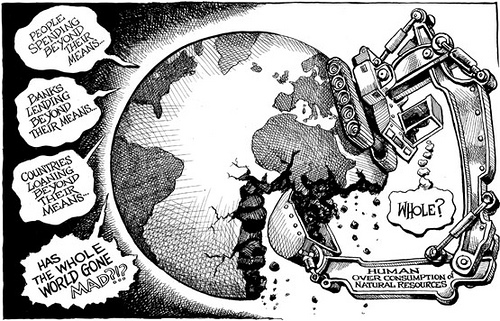
by wemakedo | Nov 9, 2018 | community, health |
By now I think most of us have at least seen headlines related to the recent IPCC update on climate change which describes the impacts of further global warming. To add to this, more recently, the World Wildlife Federation (not to be confused with the wrestlers) released their latest 2 yearly report on the state of our wildlife. Both of these reports are truly shocking in the facts that they present. And it should be noted that although there is some opinion included, these reports are summaries of the best factual data we have on our current situation. If people need more evidence of the sorry state of our global environmental health, it’s all here.
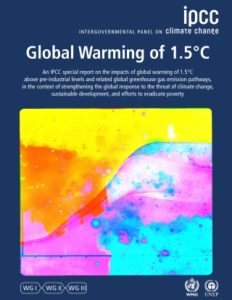 And let’s be honest with ourselves – in both reports the current situation and the prognoses are both presented as dire situations.
And let’s be honest with ourselves – in both reports the current situation and the prognoses are both presented as dire situations.
And these are not the kind of “dire” situations where for example, jobs are lost or economies are down turning or prices are rising or a storm is coming or some of the other crisis events that preoccupy our media all the time. This is on a whole other level, like the destruction of the planet level. I don’t know whether humanity has ever before knowingly faced such a huge imminent problem and responded with such an apparent lack of urgency.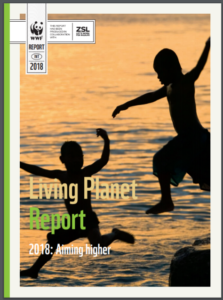
Is this sinking in at all?
For those who are perhaps climate change sceptics or merely indifferent to it all, and feel that consequences that are still years away are not to be taken too seriously, then the WWF report makes our situation clear and the cause of this situation even clearer. The report directly blames our consumption habits: “Runaway consumption has decimated global wildlife, triggered a mass extinction and exhausted the Earths capacity to accommodate our expanding appetites”
As the head of the WWF declares ominously in the report, “we are the first generation to know we are destroying our planet and the last one that can do anything about it”.
Why are we not all talking about this with the urgency it deserves ???
Why is our media not saturated with more discussion on this?
For some perhaps these are just yet more of the same kind of reports that preach doom and gloom, and that we need to do our best to not get dragged down by. But for those who are listening to the message contained here, there is a lot to be very worried about now and alot that we should be taking far more drastic action on.
We are clearly in a crisis situation that we are either paralyzed to act on or simply too self-absorbed to even notice despite the very clear warnings we are now getting.
It seems like most of us are hearing this message and choosing to believe that life will just go on as normal, the way it always has. Perhaps we are tending to make a subconscious decision that we can’t affect this with our individual habits anyway or that if it really was such a big deal wouldn’t our government be taking more radical action on this on our behalf?
This thinking is starting to look very foolish and delusional.
Mrs Wemakedo has recently gone back to school for some new learning on environmental engineering and so she has been reading a lot of the latest thinking on the state of the environment and latest efforts to mitigate our destructive impacts. So we have been discussing some of these concepts at home a little more and let’s just say that a quiet air of foreboding has begun to set in for us.
On some level, it’s consoling at least to see the huge amount of investigation, analysis and planning that is taking place in various fields of industrial and commercial activity to try to get a handle on the environmental side effects of our economic activity. But this seems minuscule in comparison to the huge momentum already built up by the destructive methods we have engaged in unchecked for so long now.
The latest IPCC report is attempting to put in clear terms what needs to happen to avoid near certain disaster for much of the world’s population. It lists climate-related risks to health, livelihoods, food security, water supply, human security and economic growth. That pretty much covers a lot of what we consider important in life, so maybe we should listen harder this time? Avoiding these catastrophic scenarios will require far-reaching and unprecedented changes in society!!
The WWF report is equally stark. Since 1970, we have now wiped out an estimated 60% of all creatures with a backbone (vertebrates) due to our unrelenting destruction and pollution of the environment.
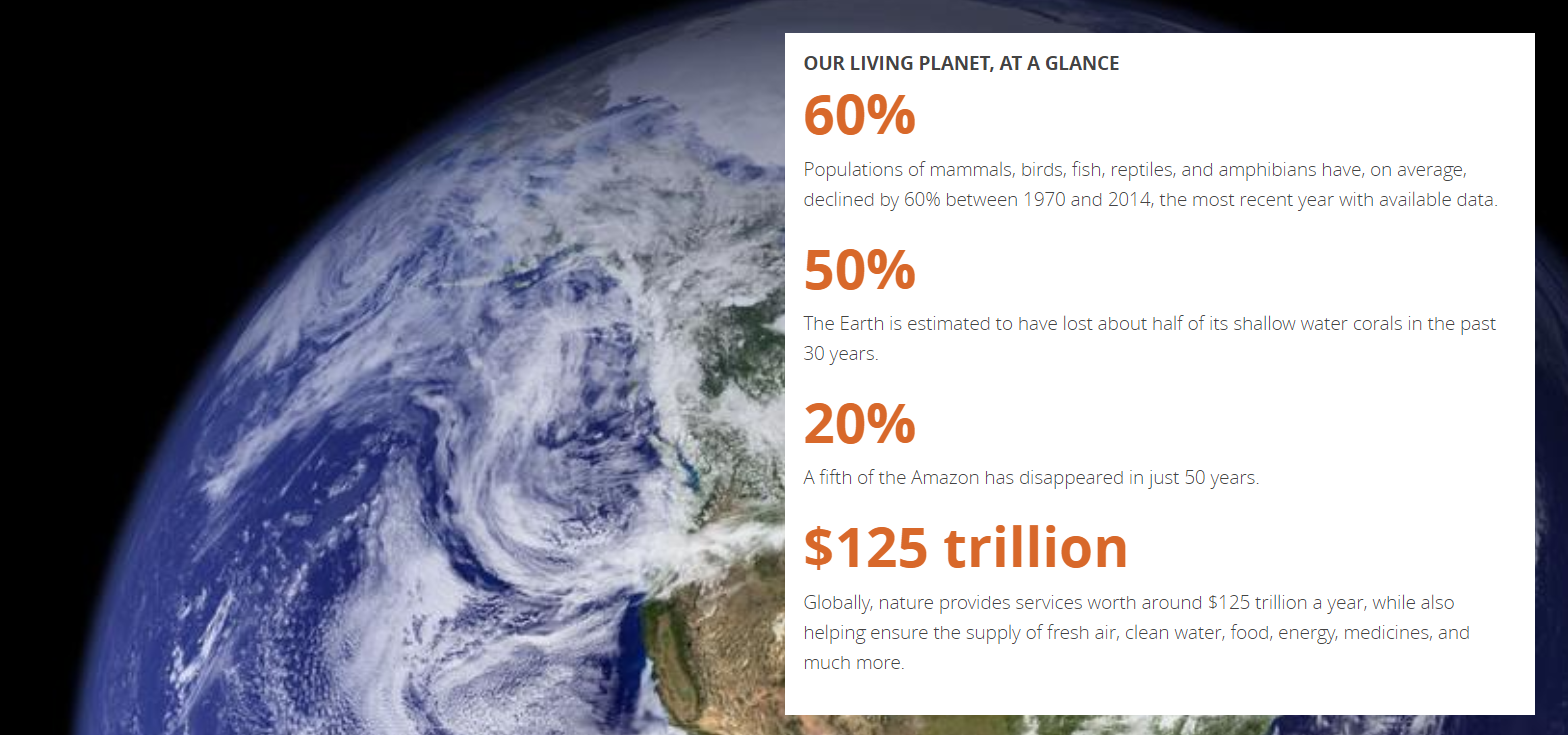 A little background on the IPCC report: this report was commissioned in 2015 after the Paris Climate Accord when it was not really clear what would happen if the world were to limit the global temp increase to 1.5C above pre-industrial temperatures (before 1900) versus limiting it to 2C. This report was requested to go figure out the real world scenarios in both cases.
A little background on the IPCC report: this report was commissioned in 2015 after the Paris Climate Accord when it was not really clear what would happen if the world were to limit the global temp increase to 1.5C above pre-industrial temperatures (before 1900) versus limiting it to 2C. This report was requested to go figure out the real world scenarios in both cases.
It doesn’t sound like much but keep in mind we are now (2017 data) believed to be at about 1C higher (within 0.8 to 1.2C (– high confidence)) already and accelerating! Some climate scientists are adamant that we are even higher if a less conservative analysis is applied to the available temperature data.
The CO2 level is not static or even slowly rising – this is actually ACCELERATING according to the latest data collected.
The report makes it clear that if we stopped emitting CO2 now, that is, immediately went to a zero Carbon society across the globe, that the impacts of what we have done will persist for decades and likely millennia in the form of environmental damage. If you pause and think about this it’s very worrying in itself…but then consider how well we are doing at slowing this down for the future.
It’s simply not happening.
As one researcher said “we are sleepwalking to a disaster with climate change”. And here is where the really concerning findings occur.
If we were to limit the damage to the scenario of a 1.5C increase then we would have to be at zero Carbon output by 2050!. That’s dropping from the highest CO2 output levels we have ever experienced to zero in just over 30 years!
The report estimates that we will reach 1.5C above pre-industrial levels (from the current 1C) by somewhere between 2030 and 2052.
So in the next 12+ years, we will see the far more serious consequences of this unchecked behaviour.
Let’s take an example from the report to get some idea of what this could mean. At the 1.5C mark, it is estimated that we lose 70 to 90% of the worlds coral reefs…that’s 90%!.
At 2C, this goes to 99%. No more coral reefs.
For many of us, it’s hard to identify with this as we likely won’t suffer much directly from having no more coral reefs – those pretty features favoured by underwater documentary makers. But to say that we might just be about to permanently kill them all off without much of a second thought is distressing. For those with children, imagine how you would explain this to your kids….”yeah, we knew it was happening but didn’t seem bothered enough or organized enough about it at the time to do enough to stop it”.
The report even mentions the use of extreme “geoengineering” as one possible solution to be considered given the dire situation we face. A quick internet search reveals that this is not a new concept to try to tackle the problem but is one that is now being mentioned more frequently as those in the know realise that this intractable problem looks to be one that is just that – intractable. We really just can’t seem to help ourselves.
One of the geoengineering ideas floated is to fill the clouds with Sulphur to mimic what happens after major volcanic eruptions when sulphur dioxide is ejected into the atmosphere and converts to sulphuric acid which is then able to reflect back lots of sunlight leading to a large temperature drop. It has worked during previous large-scale eruptions so could possibly be made to work artificially. However as these articles point out, if this could be done and if it was to work, this would only buy some time to fix the underlying CO2 generation problem but if you stop doing this engineering without having changed the background CO2 problem then the sudden temp change would have “disastrous effects” on our climate. It’s a last resort option to avoid the 2C temperature rise scenario, and one that needs a lot more figuring out, but maybe we need to start thinking in terms of last resorts now.
ref : https://earther.gizmodo.com/the-machines-that-could-darken-the-sun-to-stop-climate-1825452265
The world is full of legacy systems and methods that have been handed down to us as “the way things are done”. Knowing the way to do things from our predecessors allows us to go further and make progress in different areas without having to spend time relearning the basics. It’s how we progress
But then we also know the benefits of being able to disrupt the status quo with innovative thinking – take for example the prestige associated with an entrepreneur realizing that they can achieve some economic output in a far better way than before. These people are our modern day heroes.
Shouldn’t this disruptive spirit be channelled more urgently towards this crisis situation we face?
We have adopted some truly terrible ways of doing things that we seem to be unable to even acknowledge, much less be bothered trying to disruptively change them. Unfortunately, there are many agents who are incentivized to ensure that you don’t think too hard about some of these behaviours and question the methods that have been handed to you as, simply, “the way things are done”.
Think about the way cigarettes were sold to the public and how long it took before the medical evidence was able to break through the momentum this industry had built up on the back of high profits.
Think about the way cars are sold to us as, electronics and so much of the other crap we digest at increasing rates.
Think about the consumption of non-essentials in general. The only model we know seems to be to sell more stuff to more people to make more money. Where is this approach leading us? These reports are laying that destination our clearly for us now in ever more dramatic terms.
We should not be so naïve as to think that the way we are shown to behave by those with strong incentives, is in any way aligned with our best interests. And it would seem that we don’t yet see how closely our own best interests and the environment’s best interests are intertwined. If we were being trashed by hurricane storms with increasing frequency in Ireland would we start to wonder more about why this was happening? Woud we thne feel the need to take more personal action on our daily habits?
Where has our critical thinking gone in order to be able to see what is going on around us at a time when it’s not possible to hide all this evidence any more
Recently we watched a BBC documentary about the damage being done by the fashion industry. It was shocking for two reasons. The first reason was that it has extremely high levels of chemical pollution associated with its processes which seem to be going unchecked and at the same time that industry has managed to trick us into wanting new clothes at much faster rates than before…
so what you may say? many industries have managed to quietly pull this trick on society with their own particular play on our needs and insecurities.
But what was really shocking is how well the fashion industry seems to have managed to keep this one out of the limelight. At least for us as we watched it, we were shocked to realise how bad that industry really is while maintaining a relatively clean image. Remember when we became aware that some clothing companies were using child labour to make clothes, and how quickly public pressure came to bear to try to stop that practice?
Well, all the while the clothing production companies have been quietly trashing their local environments while helping eager high street buyers stay “up to date”. This documentary is worth a watch if you need some more shocking evidence of why a seemingly benign industry is, in reality, doing horrendous damage… second only to transport in the level damage that it does (link)
Taking time to look around, the environment seems like just one of the many problems we face. But as these two reports are clearly telling us, we need to stop ignoring or underestimating the severe consequences of what we are doing to the planet. If there is a solution to this it lies in our individual habits….no self-interested government is going to fix this. On a local level, people may have forgotten that improvements that get made by governments only come about in response to public demand. The urgent change needed will only happen through people taking their own actions to change.
We must realise that the effects of the environmental damage we are doing are no longer far removed from us in the first world. We are in a crisis that now needs an individual response. As both these reports make clear, we are at the point where we may be the last generation that can possibly do enough to reverse this.
We’ve heard the message again and again. How much more convincing do we need?
We shouldn’t need to be forced to act in the best interests of our future.

by wemakedo | Feb 27, 2018 | money, transport |
We had been nursing a very old car along for 15 years until it recently expired with a whimper. My most recent “fix” was to drill holes in the floor to let out the water that it had been accumulating, so its days of useful service were numbered.
To be honest the car was already 8 years old when we bought it making it one of the oldest things I’ve seen on the road at 23 years of age when it finally had enough. They just don’t make them like they used to..this thing had never had its clutch changed or touched in any way and after 23 years of service, the clutch finally wore out.
Our 1995 Micra was dead – or at least a clutch replacement didn’t seem worth the cost to us.
Moving on, we figured we would at least give some thought as to how we might manage on a single car. But with three young school going kids and living in the country this proved to be very difficult. In the end, it was simply too difficult for us to manage all the demands and we decided that our best option was to limit the harm we would do with our next vehicle over its life – the obvious answer here is an electric car (or EV – Electric Vehicle).
We looked for and found a 2013 electric Nissan Leaf and decided that was the way to go.
For a second car we didn’t want to splash out, firmly believing that cars are about function rather than looks. More of an unfortunately necessary waste of money and a highly depreciating asset as well, than a pleasurable investment.
Browsing the relevant websites brought back those familiar feelings of how much the car dealers profit from used car sales and how private sales offer good value if you can evaluate the car to your satisfaction.
The interesting thing about purchasing a used EV from a private seller is that relative to combustion engine cars, these cars have very little that can go wrong. The state of the battery is the obvious main concern, but really they are a considerably lower risk purchase to make than a standard car with so much unseen mechanics that can go wrong. How would you ever know if a clutch was about to go? Does it burn oil? Are the engine gaskets in good shape? Did the timing belt really get changed?
Not on an EV – it doesn’t have such hidden liabilities.
The EV will display its travel range to you and although apparently, it may be possible to tamper with this, there is a nice cheap app that you can use, along with an OBDII code reader to query the car and see the true battery lifetime (in AmpHrs) remaining. So you can know exactly what you are buying, and decide if you can live with that range.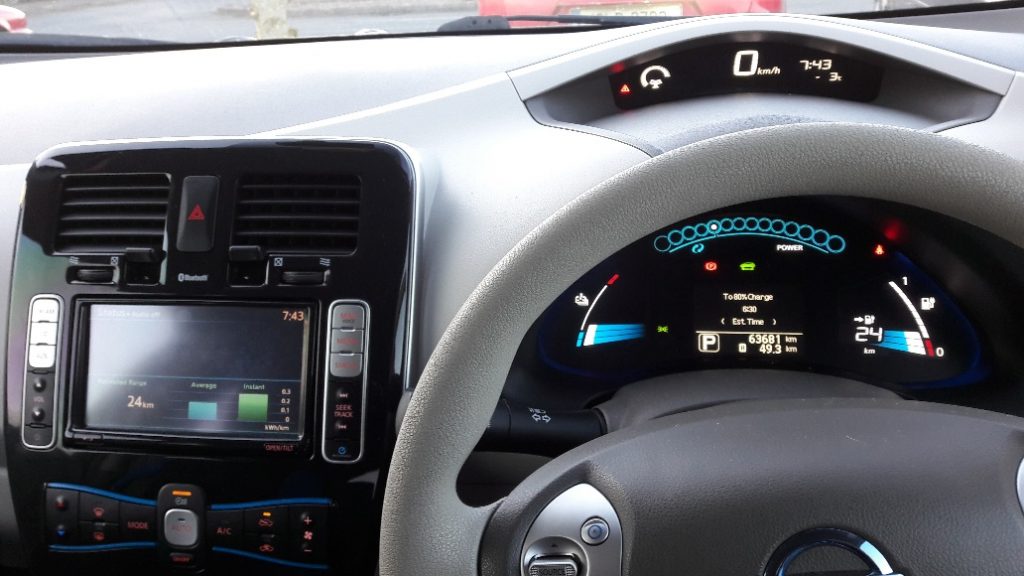
In truth, there seems to be excellent value to be had now in second hand EVs due to the fear associated with used batteries.
Yes, the batteries, of course, will degrade over time and usage and the range consequently drops off. But if you need more than 90 or 100kms daily range then one of these is not for you anyway. But with national daily average mileage at about 27 to 30 miles, then these used EVs can suit many people’s driving habits. But thankfully for us, the uncertainty in buyers minds and the aversion to having to manage your range closely means that second-hand EV prices represent great value.
So we bought it – €7300 euros for a 131 car with 60k km on the clock and 11 of 12 bars range showing.
This particular model had some of the improvements that Nissan made on the original 2011 Leaf design, but still some of the drawbacks. It had the lower capacity 24Kwh battery pack and it also still had a resistive heater which consumes significant power from the battery during cold weather, unlike the newer models which use a heat pump. Considering this and the fact that it had 11 of 12 bars battery capacity remaining we were delighted to spend that to get a nearly new car.
My introduction to driving an electric car, however, was not pleasant.
I bought the car in North County Dublin and planned my drive back to Cork. A few things I learned the hard way:
Dublin has many fast charge points which include the charging cable. When you buy a car that only has a “granny cable” – that is one that plugs into a regular household socket for slow charging – then you are S.O.L. when you pull into one of the many charge pints that require you to have the custom cable/connector. Picture my smile fading as I found my first charge point well outside Dublin with 15 km range left only to realise it didn’t have any connector. Nor did I.
After the new understanding of how this worked settled in and the panic subsided, I realised I had enough in “the tank” to barely make it to the next charge point which did include a connector. I began to realise that my charge point options were now very limited without a cable.
To be fair the infrastructure in Ireland is good, and once you understand the different types of charge points and carry the right cable, getting around over long distances is easy although time-consuming when you factor in the charging time.
On that trip, however, I also learned that a very cold and windy day will significantly impact your range due to wind resistance and if you decide to run the heater to warm yourself. I watched in horror after charging up to the max as the kilometre range value predicted by the car started dropping as I drove along, dropping a lot faster than the kilometres I was covering on the ground.
And so at the height of my misery on that cold Friday night in February, as I huddled in the freezing car at 11:30 pm in a deserted garage forecourt waiting for the nice Nissan breakdown recovery people to find me, with only 10km range left but no charger-point within range – these simple points were becoming well understood:
• Don’t drive so fast on the motorway!
An EV is best driven conservatively on the open road, that is to say, 95 to 100km/hr will deplete your battery a lot faster than 85km/hr.
• Turn off the heater until you really need it!
• Use “economy mode” driving for longer journeys to maximise your range
• Pay attention to the charge point information and which kind of charger you are aiming to stop at, they are not all the same.
I’m sure this information is pathetically obvious to experienced EV drivers as it is to us now having learnt the hard way. But when you are caught up in the buying frenzy, don’t forget to realise that driving an EV is a very different experience to the heedless driving we are all accustomed to in gas guzzling cars with fuel stations everywhere.
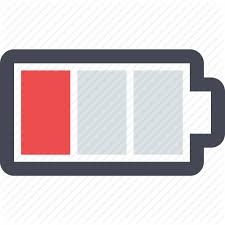 You may have heard the EV related phrase known as – “range anxiety” which newbies experience as they learn to manage their electric car’s needs. It’s real!
You may have heard the EV related phrase known as – “range anxiety” which newbies experience as they learn to manage their electric car’s needs. It’s real!
But it’s treatable with some experience and practice.
I was traumatised by my first long journey experience in a car that should not have been used to cross half the country on a freezing, windy Friday night with no suitable charge cable and a steep learning curve ahead for its new owner.
But now that we understand the range limits and use the car accordingly, we love our electric car and highly recommend them. It recently made the trip to Dingle, covering 135kms with a top up in the middle.
Making that journey was like getting back up on that bike that gave you your first bad fall. That trip repaired the trust and now we’re on the best of terms with our trusty EV. Second hand, the Nissan Leaf is a good value option for households that prefer to own a second car. We highly recommend you consider one if you are in the market for a new car.

by wemakedo | Feb 6, 2018 | family, money, reuse |
The way Christmas unfolds in Ireland seems to bring conflicting emotions with it. We, like most parents, like to bring some “magic” to the occasion for our children, but it’s a real struggle to do this without feeling like one is on a slippery slope of wanton waste and mindless consumerism. Having been out of the country for several previous Christmas periods, this year we were exploring how we wanted Christmas to feel in our home. It started well with some intentions to engage the kids in some acts of giving each week in the run-up. We didn’t want them to start believing the whole thing is just about the gifts and “what’s Santa bringing you?”.
The amount of times well-wishers will ask kids this question during December is staggering and somewhat irritating. How could children who hear this refrain repeatedly, think about anything else other than their list of stuff and what they are entitled to?? We seem to be hell-bent on spending a month every year teaching them to want things!! Toy companies must be so proud of how well we’ve all bought into this!
Anyway, in the end, we got suckered in; we absorbed the “Late-Late Toy show”, visited more than one “winter wonderland experience”, bought the “Elf on the Shelf” and had our vague good intentions swept aside, and we pretty much signed up for the whole consumerist shebang. Plastic battery operated toys were purchased in spades based on the aforementioned critical Santa “list” and our Christmas morning turned into a whole lot of stuff strewn about the house with the kids obviously confused by the quantity and what to do next with it all. It doesn’t take long before this is the norm and expectations are set for future Christmas’s to come.
 We did at least try to use fabric to wrap the stuff under the tree which worked well, but there was no doubt that the whole event was too much about the purchases despite some vague earlier intentions to inject some other values into the occasion and try to give it a broader meaning. The whole idea of teaching kids to be good so that they can get more stuff from Santa on Christmas day seems like such an outdated lesson to giving our children. What natural conclusions would young minds draw from this as they see it played out year after year at Christmas time? It’s a very self-interested and greed-inducing message to give. Isn’t it time we moved on from this?
We did at least try to use fabric to wrap the stuff under the tree which worked well, but there was no doubt that the whole event was too much about the purchases despite some vague earlier intentions to inject some other values into the occasion and try to give it a broader meaning. The whole idea of teaching kids to be good so that they can get more stuff from Santa on Christmas day seems like such an outdated lesson to giving our children. What natural conclusions would young minds draw from this as they see it played out year after year at Christmas time? It’s a very self-interested and greed-inducing message to give. Isn’t it time we moved on from this?
Something that struck us as we look back on Christmas 2017 is that if you want to do something a little different with the occasion, then you really have to know what you want to get from it and be proactive in your efforts to go after it. Somewhat unclear intentions of trying different things may get overwhelmed in the surge of messages that bombard us all. In a small country like Ireland, “the way things are done” can be a powerful current to swim against.
The Community Reuse Network of Ireland is running a campaign in January which encourages us to re-gift and pass on the unnecessary stuff we have accumulated. Hoarding stuff that we don’t need or use is a sure way to clutter your life. It’s wasteful too, at a time when the world is producing too much. This campaign is encouraging people to “Think a bit differently about January and see it as a month of giving back and decluttering – giving unwanted presents to charity shops, sharing decluttered items on Free trade sites and recycling any unwanted holiday waste and electrical goods”.
Note that the Babymarket.ie is continuing to offer a great way to sell your used child-related items and to help new parents to save some money.

 We also spent the month of December (and November, and October…) glued to the price of Bitcoin. It’s a digital currency or “cryptocoin” that has been in operation since 2010 and has recently become more widely known.
We also spent the month of December (and November, and October…) glued to the price of Bitcoin. It’s a digital currency or “cryptocoin” that has been in operation since 2010 and has recently become more widely known.
You may have seen the news stories late last year as this niche technology captured much wider interest and began to be covered extensively in the media due to its massive gains in value (see the plot shown indicating the exponential rise in value that took place as compared to other asset bubbles).
Having followed it for a few years we decided to buy a very small amount of Bitcoin in September 2017 and were fortunate to experience some of the recent massive surge in value it experienced last year. Huge levels of new interest in this digital currency with only 16 million units in circulation, led to a price increase from approximately $3500 per coin in September to nearly $19,000 in December. It has since crashed back down to $8,000 though and still dropping. But such are the dizzying highs and lows of crypto-coin speculation.
It is interesting to watch the varied commentary when something like this happens. On the one hand, there are those who have bought into this vision of the future and see Bitcoin (and other cryptos) as a future “currency of the people” and say it will soon be worth hundreds of thousands of dollars per coin. A universal currency that is not controlled or manipulated by banks or governments has a certain appeal for lots of reasons.
On the other hand, there are those who represent the established banking industry or government regulators who are making dire predictions of a total collapse of this absurd speculative bubble based on a meaningless creation.
The truth about Bitcoin and other digital currencies is probably likely to be somewhere in between these two extreme predictions. There is enough interest in the technology that there seems to be no doubt it will survive in some form.
As with all disruptive technologies, there are incumbents who are unsettled by its potential and have much to lose when their own industry is threatened…i.e. bankers and government regulators. While those first movers who believe in the technology will vastly exaggerate its potential in order to drive others to get on board.
The argument that Bitcoin is in reality worthless seems strange as, so are all currencies (pieces of paper after all) except that governments back them and give them value. Hence you know your paper Euro has value, but we also know what happens when governments collapse and currencies devalue extraordinarily as is currently happening in Venezuela. This does happen and suddenly a currency can become near worthless when the trust breaks down.
As something like Bitcoin gains acceptance then it will of necessity gain intrinsic value from those who believe in it and are willing to transact it and assign value. The problem, for now, is, of course, its volatility. It’s getting harder for people to sign up to use it when its price is moving by so much and so quickly.
The counter-argument made in favour of Bitcoin is that while unlikely to replace regular currency, it represents a new way to store value in the place of gold. Not that many of us tend to buy gold these days to store value, but you get the idea. If Bitcoin can be readily purchased by anyone with a pc and stored safely (this may be an issue) and it keeps or grows in value over time, then it represents an improvement over gold.
The obvious comparison to make here is to the buying of company stock. When you buy stock in a company, you are investing in the future growth potential of that company. So when your investment goes up, is it because some tangible economic value has been delivered by the people in that company and so you are sharing in the increased company worth as your stock goes up. This doesn’t really apply to the crypto asset class, however, as there is currently no obvious intrinsic value to use in order to figure out if its price is reasonable or which direction it’s likely to go. Hence it is for now pure speculation and everyone buying it is hoping that they are not the last buyers. Hence it is very very volatile and very unpredictable, but this is not unusual for such a disruptive new technology.
It is certainly an interesting phenomenon that is in the very early stages of its development. We have decided to ride out the volatility with our little investment to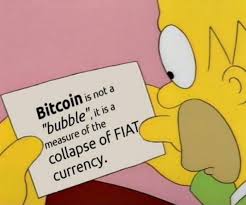
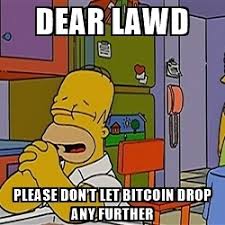 see where this all goes. Remember the Internet in the late 90’s when many apparently silly ideas with a “dot com” attached to their names would surely change our lives dramatically in the future, and these ideas were driving massive speculation in stock markets prices. And then it all burst in the economic crash of 2000. With hindsight, we can now see how that has played out after all the crushed dreams and silliness are gone.
see where this all goes. Remember the Internet in the late 90’s when many apparently silly ideas with a “dot com” attached to their names would surely change our lives dramatically in the future, and these ideas were driving massive speculation in stock markets prices. And then it all burst in the economic crash of 2000. With hindsight, we can now see how that has played out after all the crushed dreams and silliness are gone.
Yes, it was a bubble, but yes the technology did change the world dramatically once people figured out the true value in it.
There may be something to this Bitcoin thing.
Watching this Bitcoin story unfold in December certainly added a different angle to the Christmas cheer in our house: while kids were drooling over the latest toys that might make the Christmas list, Dad (at least) was drooling over the surge in Bitcoin value.
But then the hangover set in..
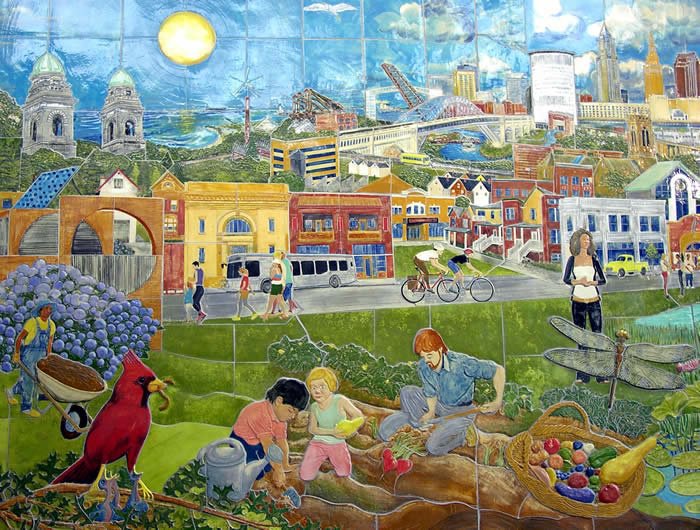
by wemakedo | Nov 10, 2017 | community |
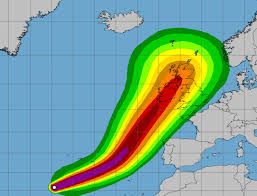 Our recent brush with the formidable Hurricane Ophelia and then a week later with the more colloquial sounding storm “Brian”, may have shaken our thinking that nothing very seriously bad ever happens in little ol’ Ireland.
Our recent brush with the formidable Hurricane Ophelia and then a week later with the more colloquial sounding storm “Brian”, may have shaken our thinking that nothing very seriously bad ever happens in little ol’ Ireland.
We are used to watching TV footage of storm-ravaged homes and people whose lives have been turned upside down in areas we typically associate with hurricanes, earthquakes and other natural disasters. But maybe now we can feel a little more empathy towards those situations and realise that natural disasters are perhaps something we should give a little more thought to in this part of the world.
Our WeMakeDo family philosophy has at times swung from the milder form of doing what we can to limit our harmful impact on the world to sometimes more extreme thoughts of how would we fare in the event of an extreme disaster where some degree of self-sufficiency may become very important.
The Normalcy Bias – sometimes also called the ostrich effect – is an effect that biases people’s thinking when faced with the prospect of disaster. We all tend to have this bias to varying degrees which dictates that things will continue to be normal because they have always been normal. This bias can come into play when we face a potential disaster situation and try to plan accordingly. The bias will tend to make us think things will never be as bad for us as we know it can be for others.
In true Irish fashion, before Ophelia struck, there were jokes going around about how Guinne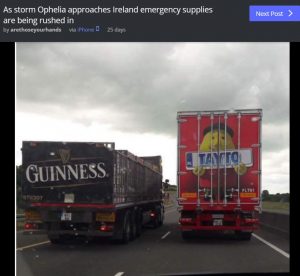 ss and Taytos were all that was needed to weather it out. Maybe we just are that relaxed about things but perhaps there was some Normalcy Bias at play. It can result in way over-optimistic interpretations of warnings as well as an inability to cope well when faced with real disaster situations when they do occur.
ss and Taytos were all that was needed to weather it out. Maybe we just are that relaxed about things but perhaps there was some Normalcy Bias at play. It can result in way over-optimistic interpretations of warnings as well as an inability to cope well when faced with real disaster situations when they do occur.
Ophelia has been a striking example of why we should acknowledge that this kind of event can happen here. We should not assume we won’t experience disaster just because we have never really experienced it in recent memory.
Watching the aftermath of the storm unfold was interesting. It would seem that other than some specific tragic incidents during the storm, the broader population was merely inconvenienced by this storm. Our family like so many others lost our power, but only for a day and our water supply for the same time (as we are on a well). Others around us lost their power for a week and daily life for those families was certainly tough for those few days. What was eye-opening is how truly helpless we can be when we lose centrally supplied power or centrally supplied water. The loss of internet access in our home for a day was difficult enough!
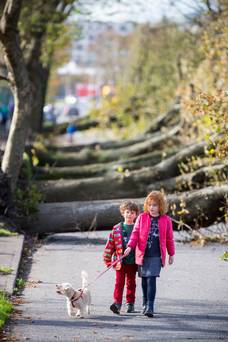 Power was slowly restored and roof tiles were replaced and life went on for those of us less impacted by the storm. But should we give a little more thought to how well set up our current way of life is for dealing with large-scale disaster?
Power was slowly restored and roof tiles were replaced and life went on for those of us less impacted by the storm. But should we give a little more thought to how well set up our current way of life is for dealing with large-scale disaster?
It’s not so much that we should expect to have to deal with large storms like this on a more regular basis although this may become a feature of our altering climate; its more that we have become very dependent on centralised supplies in our modern lives. Our normalcy bias has us believing that this way our highly inter-dependent society is now set up is not at risk at all. We generally don’t even give it a second thought.
Assuming normalcy means that we assume there will always be a supermarket to get our food, water will always come out of the tap, and our lights will always turn on when we flip the switch.
The purpose of this article is not to suggest that we should introduce paranoia into our daily lives but perhaps we should give some thought towards how we could manage in the event of minor emergencies or disaster situations and how we can improve either our self-reliance or our local reliance. We should not assume that the government or the free market will always be able to provide for us in crisis events and believing this may be quite naive.
Through pursuing economies of scale and profit, big business has slowly been changing how our communities acquire goods and services and also who is able to provide these goods and services. Food supply is obviously an important aspect of a resilient community. Most of us are aware of how large supermarket chains squeeze small food suppliers out of existence. Thankfully in Ireland, it seems there is no shortage of small food producers who by their existence, add a high degree of resilience to our communities.
Other concepts which can help build community resilience and strengthen connections:
- Food co-ops where people buy produce in bulk and distribute it amongst members of the community who join up.
- Local currency initiatives – such as the Kilkenny “CAT” which was proposed in 2010 but doesn’t seem to have happened or the thriving local versions in some UK cities like the Bristol Pound and Liverpool Pounds, which serve to encourage money circulation within local enterprises and communities.
- Lending libraries are a relatively new concept in Ireland and have started in Dublin: the same concept as book libraries only for other household items such as tools, garden equipment etc. The kind of things many of us only need occasionally and so can be better shared rather than owned with little use.
- Well attended farmers markets which incentivise local producers to meet local needs.
- LETS or Local Exchange Trading Systems which relies on credits and not currency to exchange skills and resources. This bartering system allows for people to trade skills and provides a useful outlet for people with skills to trade for other needs. Cork has such a system set up: Cork LETS Network
Another thought we had when we lost our power for a day was: for people who like to figure things out for themselves, how much of the wealth of online knowledge do we actually retain so that it might be of use to us if the electricity supply failed for a significant period of time. The WeMakeDo family love to try fixing things making use of the wealth of online guides and resources now available, but one wonders how much of that knowledge do we retain? With no power (and no internet) one wonders if one could figure out how to make, for example, a manual well pump to get a supply of water?
It’s not likely that our lives would ever depend on figuring this out, but it’s food for thought.
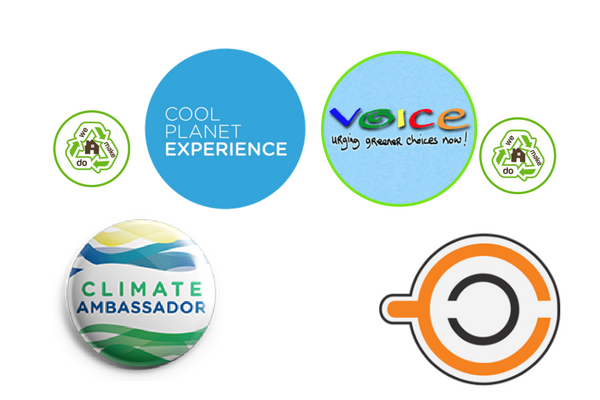
by wemakedo | Oct 6, 2017 | family, Plastic Free July |
“The wind of change is blowing through this (continent) country. Whether we like it or not, this growth of national consciousness is a (political fact) possibility?”.
– British PM Harold Macmillan in speech given in South Africa concerning decolonisation (with some modification)
Here in the WeMakeDo household, we try to ensure that we are at least considerate of our impact on our surroundings as best we can. We try to bring this perspective into all our family decisions because we feel it is a must for the sake of our kids’ future and the state of our surroundings.
With ridding ourselves of single-use plastic as our current focus, sometimes arguing over who “buckled” and bought another plastic bag of frozen peas or who owns the plastic water bottle that appeared in the bin may seem like we have nothing better to do. But to make the change stick, it’s important to question everything and to realise why it’s worth questioning these seemingly trivial everyday household decisions.
“When you bought that plastic bottle, you assumed responsibility for it now being part of our collective waste pile and for being a burden on the environment that your children will have to deal with as it hangs around for a hundred years!”. etc. etc. finger wagging included.
We don’t quite go that far….usually.
It’s easy to sometimes think that for every plastic bag of peas you forego (even though you love peas), that there are so many more being purchased and discarded that it can’t possibly make any difference. But it’s also important to remember that, as with any shifts in popular thinking, lots of seemingly small efforts to change the status quo can lead to tipping points in social behaviour which will then transform what is deemed acceptable behaviour by the majority. Think of smoking in public buildings or the use of plastic bags in supermarkets in our recent past. Granted these high profile changes were enforced by law in Ireland but how quickly they were accepted and generally lauded gives hope for other more subtle approaches to causing a change in our attitudes.
We have started to notice a significant groundswell of new awareness around environmental issues in Ireland in the last few months which looks to be part of a fabulous next step towards bringing the issues to national attention. There seem to be many new efforts now that when viewed collectively, seem like we have turned a corner in Ireland and people are taking this problem seriously.
Perhaps Mr D. Trump has inadvertently given rise to a reaction against his position on climate change that may, in the long run, bring about more change than if he hadn’t tried to declare it an overblown hoax.
Here are just a few examples we were delighted to learn about in recent weeks:
 Recently, you may have noticed the “conscious cup”advertising campaign encouraging people to bring their own cup when buying coffee. From a group of simply “concerned individuals” active on the Zero waste Facebook page, this effort aims to raise awareness about the approximately 200million cups we dispose of in Ireland (15 minutes after we purchase them).
Recently, you may have noticed the “conscious cup”advertising campaign encouraging people to bring their own cup when buying coffee. From a group of simply “concerned individuals” active on the Zero waste Facebook page, this effort aims to raise awareness about the approximately 200million cups we dispose of in Ireland (15 minutes after we purchase them).
Few people would argue in favour of this behaviour but until it’s pointed out to us, then it’s easy to just do as we’ve always done.

Cool Planet Experience and the EPA have launched a Cool Planet ambassadors program which will focus on educating the general public about how to respond to Climate Change:
“Once selected, the Cool Planet will train the 26 Cool Planet Champions to engage, educate and inspire the general public in their own county about how our changing climate directly impacts them and how they can make a real, practical difference.”

 In a similar program sponsored by An Taisce with support from the Department of Communication, Climate Action and Environment, National Climate Ambassadors are being appointed to help to stimulate awareness and change at a local level throughout Ireland. The program will look for the Ambassadors to take at least 4 specific actions in their locality aimed at raising awareness and educating the public on the effects of climate change in our lives.
In a similar program sponsored by An Taisce with support from the Department of Communication, Climate Action and Environment, National Climate Ambassadors are being appointed to help to stimulate awareness and change at a local level throughout Ireland. The program will look for the Ambassadors to take at least 4 specific actions in their locality aimed at raising awareness and educating the public on the effects of climate change in our lives.
 Voice Ireland have just finished recruiting for a recycling ambassador program on a national scale. This excellent program also aims to bring about change in our waste habits by means of education. The focus here is on improving recycling rates in Ireland and trying to remedy a national issue with the poor quality of our recycled waste. This large program aims to hire 25 paid ambassadors to help educate people on household waste management and how to recycle correctly as well as collect feedback on issues encounte
Voice Ireland have just finished recruiting for a recycling ambassador program on a national scale. This excellent program also aims to bring about change in our waste habits by means of education. The focus here is on improving recycling rates in Ireland and trying to remedy a national issue with the poor quality of our recycled waste. This large program aims to hire 25 paid ambassadors to help educate people on household waste management and how to recycle correctly as well as collect feedback on issues encounte red. It seems that while in Ireland the amount of recycling waste generated is reasonably high, the quality of this recycled waste stream is not so good due to cross contamination. We’re not so good and putting things in the correct place to ensure the individual recycling or composting waste streams are “clean”.
red. It seems that while in Ireland the amount of recycling waste generated is reasonably high, the quality of this recycled waste stream is not so good due to cross contamination. We’re not so good and putting things in the correct place to ensure the individual recycling or composting waste streams are “clean”.
The hope is that this program will generate useful feedback for government bodies to use in making the process easier for people to use, leading to improved levels of recycling.
 Another example we were delighted to read about this effort in the Dail led b
Another example we were delighted to read about this effort in the Dail led b y the Green Party to legislate for reduced packaging:
y the Green Party to legislate for reduced packaging:
Bill entitled: An Act to provide for a ban on single-use non-compostable cups and other tableware and for the introduction of deposit and return schemes for beverage containers
The proposed bill which has yet to make its way through approval aims to ban non-biodegradable coffee cups and other tableware.Hopefully, this overdue response to a significant source of landfill waste will be successful.
To help understand the incentives which may be helping to drive this increased focus we have been noticing, the EPA publishes a report on how we are doing nationally on our waste handling. This report shows our performance against EU targets set for Ireland and it appears we are doing quite well.
In the table below, (ref: EPA- Progress towards EU waste targets – August 2017) the 2020 goals for “recycling” (paper, metal plastic and glass) as well as for waste quantities to landfill are shown. We were probably no waste angels in 1997 – the year our targets are compared to but dropping to 35% of that amount in 23 years sounds impressive. Having met our 2013 reduction goals, it’s looking good for the 2020 goals also, but clearly, more focus is needed to make sure this stays on track.

It’s very inspiring to see groups like Voice Ireland, “Zero wasters” and others stepping up to contribute to this transition process and make us pay attention. Mrs WeMakeDo was delighted to be awarded one of the ambassador roles in the Voice Ireland program and is looking forward to helping with their process.
Shifting people’s habits on a national scale takes dialogue, focus and a lot of effort, but it’s how the big results can eventually come about. Let’s hope we are witnessing a new tipping point in Ireland and that these great initiatives can cumulatively swing us in a new direction for the better.
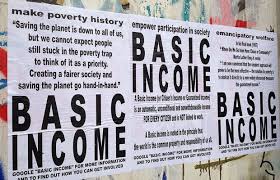
by wemakedo | Sep 8, 2017 | community, family |
This concept of a Universal Basic Income for all has been doing the rounds for a long time now and re-emerges regularly when some newsworthy person or other decides to be an advocate. Recently Mark Zuckerberg (Facebook CEO) delivered a commencement speech to US Harvard graduates in which he called for “exploring a system of wealth distribution known as Universal Basic Income”. And so followed a renewed flurry of commentary about this groundbreaking concept and how it might work. Or how it could never work.
The WeMakeDo family has been trying for some time now to experiment with tightening up our household annual costs and at the same time considering how we would live if we were to stop living off salaries from for-profit companies. Mrs WeMakedo started her own business a few years ago (the Babymarket.ie) which has been thriving but is not sufficient to sustain us yet. Mr WeMakedo has been considering ending his salaried position of 20 years simply because it no longer meets any of the higher order needs that can become more important to us as we get older.
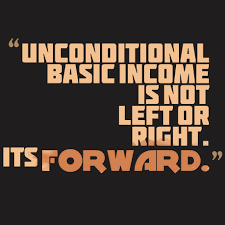
You know that itch of the soul that starts to become harder to scratch as routine and monotony starts to kick in. Working for someone else can get a little wearisome and usually change is a good thing to bring upon ourselves.
A regular salary is nice and comforting but it can be detrimental to your motivation and creativity. Unless you are one of the lucky few who love what they are salaried to do, then its seems there is a limit to how much enthusiasm one can continue to generate for someone else’s agenda when they are paying you to do it. Some would say that a regular salary is the best way to stifle creativity and ingenuity. As the insightful author Nassim Taleb (author of “The Black Swan”) has said, “The three most harmful addictions are heroin, carbohydrates and a monthly salary”.
Of course one has to be practical too and ensure that family needs that we determine to be important, can be, and will continue to be met. But in a society where self-worth has become strongly attached to one’s “career” position and one’s outwardly displayed signs of high income, we are in danger of losing sight of what really satisfies us. And when you start to figure that out, then if a salaried job isn’t in some way aligned with those sources of satisfaction, then it needs to be seriously delivering in other ways to make it continue to be worthwhile.
For some people, that satisfaction may truly come from driving an expensive car to work at a company where we feel our position also commands respect from peers. But for some, this career path we are sold may turn out to not bring that deeper satisfaction we are craving. For some like myself, it just seems to take longer for the realisation to occur and then for some decisive action to follow.
Universal Basic Income is the idea that a government will pay every citizen some guaranteed regular amount to live-on so that their basic needs can always be met. It is not intended as a means to allow people to live without contributing to society. In fact, the model intends (and some evidence suggests) that by being freed from the stress and/or monotony of having to find a way to meet one’s basic needs, it will allow for larger sections of society to engage in fulfilling and still productive activities. The model assumes that the societal gain from this approach to funding people’s basic cost of living should outweigh the direct financial costs of funding the UBI.
At its most basic, UBI will lift a large section of society out of poverty. With this approach, everyone will have enough money to live to a basic standard. The UBI also may also help growing populations deal with the emerging trends in industry which suggest that as automation and artificial intelligence take hold, there will be fewer manual or menial jobs available for the population in general.
What will the masses do if there are no factories to get mind-numbing work in? Well, they’ll probably figure out better ways to use their time. Happier people should lead to improved general well-being, health and community engagement.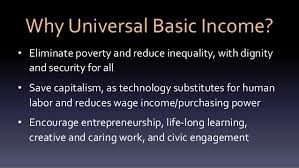
Some would argue that the free market model we currently follow in the capitalist world will force those in need of a salary to survive by whatever means is available to them, to become more inventive about how they meet their needs. But it’s hard to see how this forced creativity can be as good for society as a whole (or as enjoyable) as the unforced creativity afforded by the presence of a basic income in a UBI society.
The question of where the funding for the Basic income comes from seems somewhat contentious. In most proposed versions, taxes are raised to do this. Thus, a large scale redistribution of wealth would take place, from those who can afford to pay which is then used to stimulate the less well-off in society. In this model, it is expected that those less well-off people will now tend to put more of the (UBI) wealth back into the economy and thereby grow it significantly. In other words, after the initial shock of the increased taxes subsidies, the overall economy will grow significantly to the point where the tax burden of providing UBI is no longer felt as a burden.
All well ‘n good if you’re not part of the wealthy section of society that will feel like it has to pay for this experiment. But there is a well researched economic thesis that suggests that as the wealthy in society become more wealthy, they are stifling economies by hoarding this wealth. As they control more and more and prefer not to spend it (in order to stay wealthy), this tends to have a dampening effect on the economy.
We currently try to get around these stagnating economic scenarios by the use of “stimulus” packages such as we have seen in many countries since the 2007 financial crisis. Most often this takes the form of government infrastructure spending on roads and bridges, thereby indirectly forcing large sums of money into circulation or, also by simply printing more money for banks to loan out to borrowers which tends to be used in the US economic model. These are also just different means of infusing a stagnant economy with large amounts of cash.
Is distributing this money to individuals to use for their basic needs that much different to what we are now doing in times of economic difficulty?
It is also argued by those against the UBI, that without the incentive to work, the majority of people simply won’t do anything. And the funny thing here is that many of us tend to think that “of course I would want to be productive, but its those other (insert some adjective to describe those we think of as inherently lazy) who wouldn’t bother”.
Actual test cases of the UBI in action have shown that very small reductions in the numbers who want to work are observed and in some cases an increase in numbers takes place.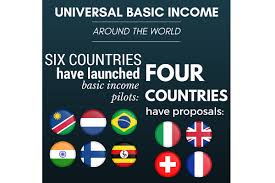
The truth here is that we all need to feel valued and to feel we contribute to our social circles in some way. And so small experiments in use of UBI have already shown that the numbers of those being productive will tend to go up rather than down once basic needs are met. The difference with a basic income in place is that the life-happiness measures go up a lot when the choices for how you make your contribution not hampered by the need to earn a salary from them.
Imagine how much more creativity we would see in such unrestricted societies?
For lots of info on what is happening to progress the Universal Basic Income movement, visit http://basicincome.org/
Now back to work.
For at least a little while longer.
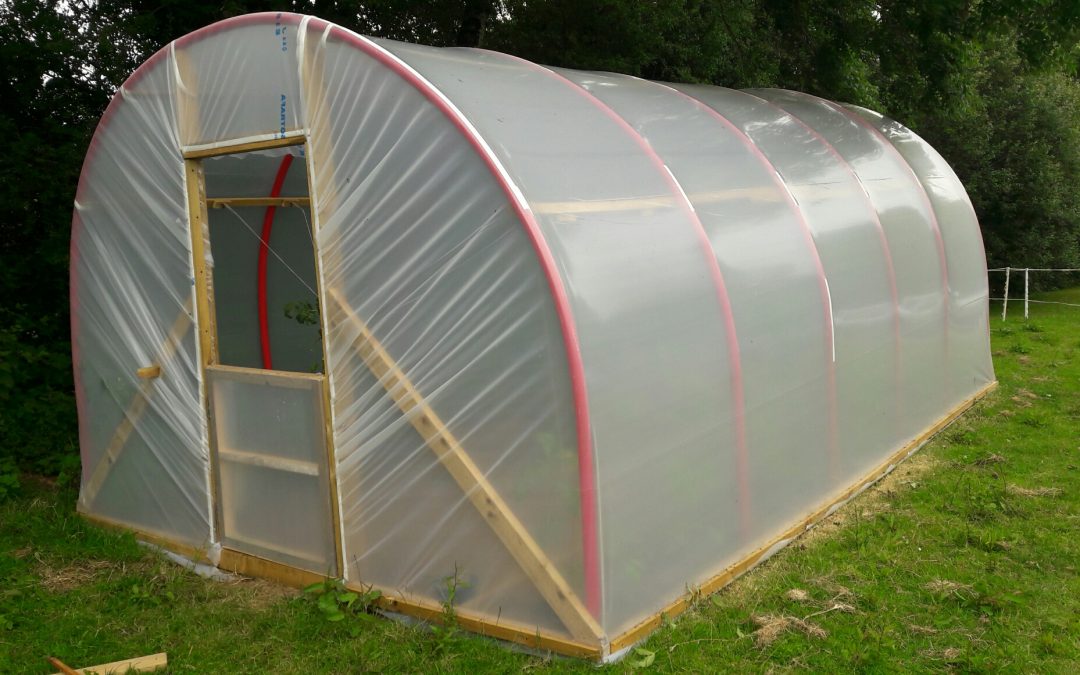
by wemakedo | Jul 27, 2017 | garden, Uncategorized |
We were delighted to finally finish our poly-tunnel in early June, just in time to transplant a batch of 20 tomato plants from pots into their new home, before they started wilting in their pots.
The plastic (polythene) cover proved to be quite easy to attach to the frame to complete the structure. (OMG! – did we just blow our whole year’s household efforts to avoid plastic – out of the water!! – we did think about this…)
The secret is to stretch it across the length of the tunnel first (from door to door) and then stretch it from side to side moving from one side to the same position on the other side to pull it taut in between. We used 2×1 sections screwed into the base boards to fix the polyethene in place. One person pulling to apply tension and the other person fixing. This process worked well with two of us helping, and we had the cover fitted in a half a day. Note also that it’s best done on a sunny day with no wind. The sun will warm the plastic and make it easier to stretch fully. This ensures it stays tight during hot weather times. The heat tape applied to the supports did make it easier to pull and stretch the plastic without risking any damage where it came into contact with rough timber. So although it may not be necessary to prevent burning of the plastic during its lifetime as it’s not in contact with any material that will heat-up, it did seem worthwhile just as a smooth contact surface in certain locations.
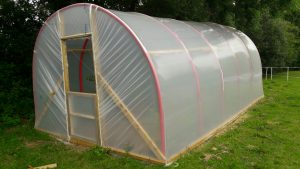 We opted to go with a half door at the front (lower half can be seen in the picture shown) so the top half can be left open for ventilation, while the other end has a large, (as yet open) vent. We figured that as much ventilation as possible is best for now until the weather turns bad again, so we haven’t finished those openings off yet.
We opted to go with a half door at the front (lower half can be seen in the picture shown) so the top half can be left open for ventilation, while the other end has a large, (as yet open) vent. We figured that as much ventilation as possible is best for now until the weather turns bad again, so we haven’t finished those openings off yet.
All in all, it was quite manageable and we are happy with our cost estimate of about half the price to build it as to buy a kit, although that doesn’t account for the time cost in putting it together which was significant.
Once the shell was finished, we used remaining 2×4” lengths to lay out the beds inside. We opted for 2 foot wide beds at the sides where access was restricted to one side, while a 3-foot wide centre bed left two sufficiently wide 2 foot paths running the length of the space. A little extra room was also left around the door for an eventual work surface or just room to “potter”. We had hoped to also include space for the kids as this may turn into a nice winter-time sheltered play area for them to get out of the house. That’s another day’s work though.
We have yet to figure out a good water supply and are opting to run a long hose from our house supply over to it for now. Eventually, we plan to collect the rainwater from the tunnel itself to use inside for plant watering. It seems this can be done easily using a stuck-on strip of plastic to guide the water off the wall a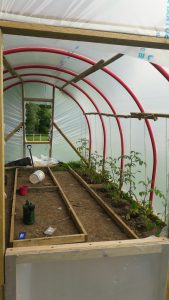 nd in
nd in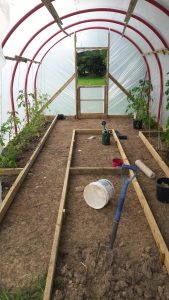 to a butt. We plan to look into this further.
to a butt. We plan to look into this further.
An interesting side note at this point is that our tunnel happens to be right beside where our deep water well (200ft) is located. So in effect, we are pumping water out of the ground, sending it into the house, through it, back out again and over to our polytunnel next to the water source. In the spirit of self-sufficiency which we are all about, we did some investigation into manual well-pumps.
We have semi-regularly been caught out without power for hours at a time. While it’s never been anything more than a few hours, still it can be quite an inconvenience if it goes beyond this, with water supply being the first problem we would encounter as we use a pressurised system.
Being self-reliant for our water supply, it’s nice to know where our water comes from and to know its quality to some degree, but we are entirely dependent on our electricity supply to access the water we need. So, what about a major disruption of power in the event of a serious storm?
It seems that photo-voltaic powered pumps are not powerful enough to lift water from such a depth, but there are manual pumps which can do this. Interestingly the major suppliers of these seem to be US based as there is quite a market there for off-grid survival enthusiast equipment. There just don’t seem to be the same options available closer to home. Perhaps we are too trusting of our service providers over here?
One example is the Bison Deep well pump which is a very expensive option but appears to be very well made and capable for such deep wells. ANother example is shown here. These pumps are about $1500 to $2000, but are well engineered and made to last. We haven’t done anything about this yet, but the idea of being able to hand- pump water for our polytunnel and for our home in the case of emergency is appealing. We don’t want to go too “survivalist” on you, but one just never knows. We all tend to be too accustomed to our comforts to really give any thought as to how we could manage in emergency situations, which can and do happen in various parts of the world.
Shortly after we finished and were admiring our work, someone accidentally had a run in with the side of the tunnel leaving a large gash in the polythene. This was, of course, always going to happen at some point, but within days of completing it! anyway, make sure to get some of the polythene repair tape sold by polytunnel suppliers for repairing the holes. It seems to work reasonably well.
Now, all we need is the sun to get our tomato crop blooming.
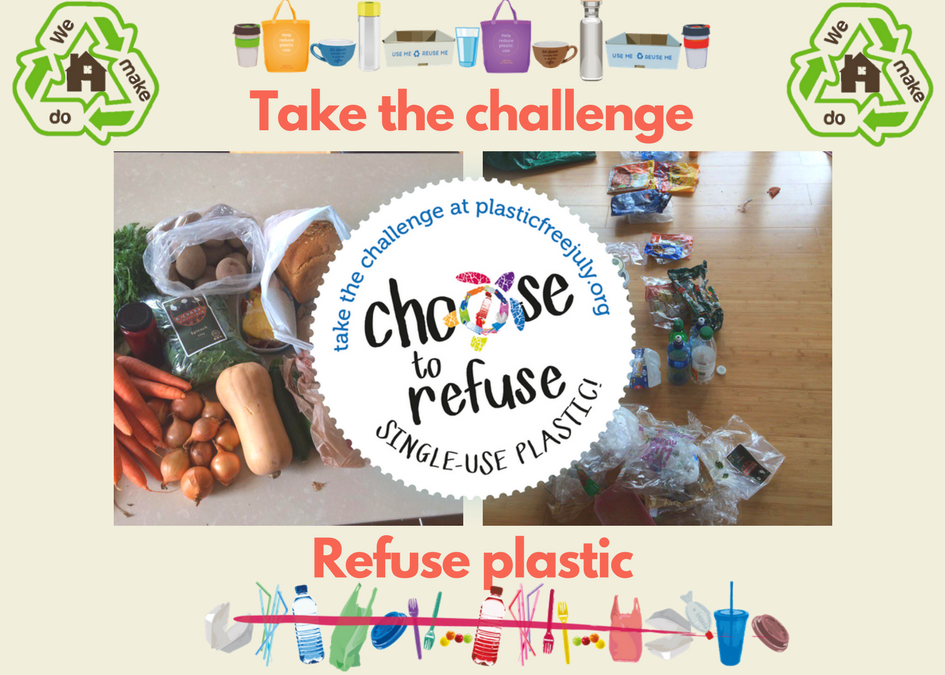
by wemakedo | Jun 29, 2017 | Plastic Free July, reuse, Uncategorized |
It’s been a year since we dabbled in Plastic Free July 2016 and now it’s upon us again.We’re happy to say that we have more enthusiasm to try it out again this year and are already well positioned in that many of our plastic-free habits have stayed with us since last year.
The biggest difference for us this year has been in going with a local fruit and veg seller who manages to remove all the packaging from his produce and will deliver to our home weekly. The other change we made is that we can purchase from a wholesale bulk foods distributor based in Macroom (http://www.iihealthfoods.com/) who carries everything you could want in large quantities.
For our first trial run, we bought:
25Kg of porridge oats (in a paper sack), 25Kg of puy lentils, 25Kg of red lentils, 25Kg or brown rice, 20kg of raisins
This is just an experiment to see how well the stuff holds and how long it lasts. In some cases, the cost savings are not much, but the reduced packaging and time spent purchasing seem well worth the effort. We are also still buying bulk nuts from www.nutsinbulk.ie, although haven’t convinced those guys to try removing the plastic from their supplies.
Sigh…only to have a bulk food store locally…we think this would really work as a business, but so far it hasn’t happened yet as far as we know.
This year rather than just try harder to keep the single-use plastic out of the house, we are setting a couple of specific goals for ourselves during the month.
- Get self-sufficient on milk alternatives
- Find other options for laundry detergent and toothpaste
As we have moved away mostly but not completely from cow’s milk, for health reasons, we have started buying more and more of the expensive non-dairy options, such as soya milk, almond milk, coconut milk, rice milk, oat milk, and my personal favorite, a coconut and almond milk blend. Lots of options to choose from and they are quite expensive to buy (€2 to €2.6 per litre), not to mention all the tetra packaging that goes with them.
What’s more shocking about these milk alternatives, is that many of them use minuscule amounts of the main ingredient (2-5%!!) and most of what you are buying is water with some sweetener and stabilizers added. Once you spot this on the pack ingredients, the idea of making you own is a lot more palatable.
And none of them are hard to make, although they can be a little time consuming. But in each case we’ve tried so far, they taste better than the store-bought options.
We opted for an easy start with coconut milk. Our first experiment used a can of light coconut milk we happened to have. One recipe looked particularly simple and called for just diluting a can with 2 cans of water and adding salt and vanilla flavoring to taste. It was quite palatable – certainly no worse than the market bought versions. The preferred method for this is to soak shredded coconut, rather than starting with the canned milk, which tends to have water and other stuff added to start with.
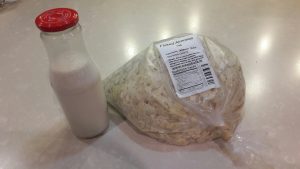 Then we tried almond milk – letting a cup of almonds sit for 2 days in the fridge in water to allow them to soak and release an acid that is best removed. Then they were drained and rinsed, fresh water was added (2 cups for 1 cup of nuts) and blended at high speed. Some sweeteners of choice can be added to flavor, such as honey, vanilla or even dates blended in. This one worked really well and got the thumbs up from the kids.
Then we tried almond milk – letting a cup of almonds sit for 2 days in the fridge in water to allow them to soak and release an acid that is best removed. Then they were drained and rinsed, fresh water was added (2 cups for 1 cup of nuts) and blended at high speed. Some sweeteners of choice can be added to flavor, such as honey, vanilla or even dates blended in. This one worked really well and got the thumbs up from the kids.
The coconut milk didn’t get much support, but then neither did the shop bought stuff either.
Rice milk is a little more time consuming to make. It requires you to boil the rice in advance and then use the rice to blend with water. Then add vanilla or cinnamon to taste as usual. Not that hard and quite tasty too.
For now we’re going with almond milk in quantity to see if we can get into the habit of making do with it. Apparently it should last for a few days in the fridge, so reasonably sized batches will work
For our #2 goal this time round, we recently attended a “Zero Waste” event in Dublin and managed to source some options for laundry detergent and toothpaste. The detergent is apparently condensed soap shavings which can be used to dilute into detergent of varying strength. Rather ambitiously, the two jars (reused also) we bought should apparently last for a year. We’re a little skeptical but getting ready to try it out.
For the toothpaste, we bought some dry powdery “stuff” – a sort of clay with all sorts of healthy things added in apparently. I think its Bentonite clay – at least I hope it is – which has excellent absorbing properties, presumably absorbing stuff that you don’t want on your teeth. The idea is to add a little powder to the wet toothbrush and the particles of clay will do the cleaning job as you scrub without damaging tooth enamel. The other natural ingredients serve to fight bacteria. So far we have noticed that one’s teeth do feel very clean after using it, but I for one miss that minty fresh taste you get from standard pastes. The jury is still out on this stuff for now – one for and one against.
So we have mostly removed the plastic from our food supplies by now, but WOW does it spread around the house through other means when you’re not paying attention! Having children makes this so much harder as much of what seems to come their way is made of plastic and has a very short lifespan.
Also, changing topics, our Poly-tunnel is finally up and running now so we’ll let you know how that’s working out in the next update.

by wemakedo | Jun 2, 2017 | Uncategorized |
No self-respecting self sufficiency enthusiast should be without a polytunnel for some amped up veggie growing. Being able to produce your own veggies at home brings satisfaction for all sorts of reasons: providing for your family, true organic food, experimenting with stuff. This is assuming that one is able to get the stuff to grow. But that’s not our concern yet. Firstly we needed to build the tunnel and so we started some research into ways to make your own.
Having read through many diy descriptions, we opted to go for a design that uses polythene piping to make the arches. In the description we were following most closely, 2” diameter black polythene water pipe was used. For some reason we couldn’t source this so instead opted for ESB ducting, which comes in a nice 50m roll for about Euros80, and is widely available. Next up we needed some steel pipe that would be hammered into the ground to act as anchor points for the poly pipe arches. This steel pipe needs to fit inside the poly pipe. So we used 1” galvanised pipe which although it didn’t give a snug fit with the ducting, the result was still secure once the ducting was pushed down over the 3ft or so of steel above ground. We had hoped to make 7 arches at 4ft spacing, giving a 24ft long tunnel, but measuring the coiled ducting accurately proved to be difficult and so when it came to the last arch, we were short. So we have 6 arches at 4ft spacing for a 20ft long tunnel. The 7.5 meter arch span gave us an 11ft wide tunnel with a good high headspace (8.5ft).That’s still a lot of room for veggies (if they grow)! You’ll notice the sloping end wall at one end. That was simply an effort to add a little more floor area inside without the additional arch.
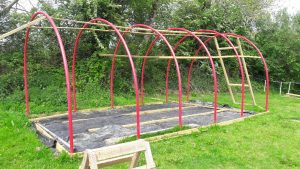
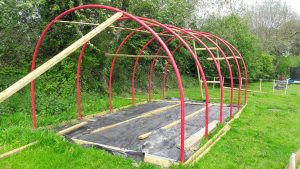
We visited some neighbors who are polytunnel pro’s to get their advice and experience.It seems that good ventilation is very important to get right. we were told It can be helped by ensuring you have a tall tunnel (with openings at either end). Hence the 8.5 ft height. The plan was to have a regular half door at one end, top half to be left open as a vent. While the other end was to have a tiltable vent or similar area. You can see the size of this vent are in the lower end in the images above. Hopefully this would be enough.
Next we went with some 4×2 pressure treated timber to use for the base rail to which the polythene would be attached as well as for the end structures to form the door and vents. Some 2×1 lengths were used to link the arches together and add rigidity to the structure. It seems that used scaffold boards are a nice and cheap way to do the base rail and provide a large area to attach the polythene too, but try as we could we weren’t able to find a local source at a reasonable price. It seems that many people are finding many uses for the surplus of scaffold boards that used to be around, and so they are now becoming a much sought after commodity for diy projects. An alternate design to the use of timber baserails, is to dig a trench all around the tunnel and bury the end of the polythene under a 1ft depth of soil. With the recent dry weather we’d been having, we figured this would be back breaking so at additional expense and less ideally we went with new 4×2 lengths.
While the structure was still being built….it is taking a while as there seems to be so much other stuff going on now with the fine summer weather…we ordered the polythene cover online from this company (www.polytunnelsdirect.ie).
An 11m by 8.75m section of 800g material we were told would be ample for our needs. We also ordered some heat tape, which is recommended for areas where the polythene touches metal or anything rough. The metal will get hot and damage the integrity of the polythene over time while any rough areas will obviously cause risk of tearing.The order arrived within a few days and is sitting waiting…
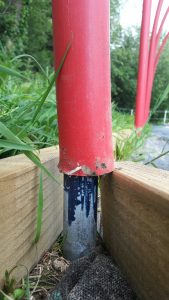
Our materials costs were as follows:
Steel pipe sections to hold up red pipe arches = €60
red ducting :€88
Timber (4x2s (10) + 2x1s (10)) = €140
polythene + heat tape = €170
total = €460;
Its a little more than I had expected for such a structure. While we are estimating that an equivalent kit purchased and delivered would cost at least twice that amount which is somewhat consoling, the labour time involved in building this so far has been significant. However there is plenty of satisfaction in taking on projects such as this yourself if you have the time to spend on it, so factoring in financial and time costs, is it still worth it?
Absolutely!
We hope to have at least the structure completed by the next blog update, even if the growing hasn’t kicked off. There is a healthy crop of tomatoes sitting in pots waiting for their new home and a chance to thrive in our new tunnel so time is becoming of the essence. We are a little late for this years growing season, but hope to get some growing use from the tunnel this year.





 A little background on the IPCC report: this report was commissioned in 2015 after the Paris Climate Accord when it was not really clear what would happen if the world were to limit the global temp increase to 1.5C above pre-industrial temperatures (before 1900) versus limiting it to 2C. This report was requested to go figure out the real world scenarios in both cases.
A little background on the IPCC report: this report was commissioned in 2015 after the Paris Climate Accord when it was not really clear what would happen if the world were to limit the global temp increase to 1.5C above pre-industrial temperatures (before 1900) versus limiting it to 2C. This report was requested to go figure out the real world scenarios in both cases.

 You may have heard the EV related phrase known as – “range anxiety” which newbies experience as they learn to manage their electric car’s needs. It’s real!
You may have heard the EV related phrase known as – “range anxiety” which newbies experience as they learn to manage their electric car’s needs. It’s real!
 We did at least try to use fabric to wrap the stuff under the tree which worked well, but there was no doubt that the whole event was too much about the purchases despite some vague earlier intentions to inject some other values into the occasion and try to give it a broader meaning. The whole idea of teaching kids to be good so that they can get more stuff from Santa on Christmas day seems like such an outdated lesson to giving our children. What natural conclusions would young minds draw from this as they see it played out year after year at Christmas time? It’s a very self-interested and greed-inducing message to give. Isn’t it time we moved on from this?
We did at least try to use fabric to wrap the stuff under the tree which worked well, but there was no doubt that the whole event was too much about the purchases despite some vague earlier intentions to inject some other values into the occasion and try to give it a broader meaning. The whole idea of teaching kids to be good so that they can get more stuff from Santa on Christmas day seems like such an outdated lesson to giving our children. What natural conclusions would young minds draw from this as they see it played out year after year at Christmas time? It’s a very self-interested and greed-inducing message to give. Isn’t it time we moved on from this?
 We also spent the month of December (and November, and October…) glued to the price of Bitcoin. It’s a digital currency or “cryptocoin” that has been in operation since 2010 and has recently become more widely known.
We also spent the month of December (and November, and October…) glued to the price of Bitcoin. It’s a digital currency or “cryptocoin” that has been in operation since 2010 and has recently become more widely known.
 see where this all goes. Remember the Internet in the late 90’s when many apparently silly ideas with a “dot com” attached to their names would surely change our lives dramatically in the future, and these ideas were driving massive speculation in stock markets prices. And then it all burst in the economic crash of 2000. With hindsight, we can now see how that has played out after all the crushed dreams and silliness are gone.
see where this all goes. Remember the Internet in the late 90’s when many apparently silly ideas with a “dot com” attached to their names would surely change our lives dramatically in the future, and these ideas were driving massive speculation in stock markets prices. And then it all burst in the economic crash of 2000. With hindsight, we can now see how that has played out after all the crushed dreams and silliness are gone.





 Recently, you may have noticed the
Recently, you may have noticed the 

 In a similar program sponsored by An Taisce with support from the Department of Communication, Climate Action and Environment,
In a similar program sponsored by An Taisce with support from the Department of Communication, Climate Action and Environment, 
 red. It seems that while in Ireland the amount of recycling waste generated is reasonably high, the quality of this recycled waste stream is not so good due to cross contamination. We’re not so good and putting things in the correct place to ensure the individual recycling or composting waste streams are “clean”.
red. It seems that while in Ireland the amount of recycling waste generated is reasonably high, the quality of this recycled waste stream is not so good due to cross contamination. We’re not so good and putting things in the correct place to ensure the individual recycling or composting waste streams are “clean”. Another example we were delighted to read about
Another example we were delighted to read about  y the Green Party to legislate for reduced packaging:
y the Green Party to legislate for reduced packaging:















